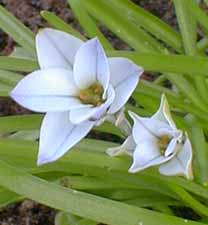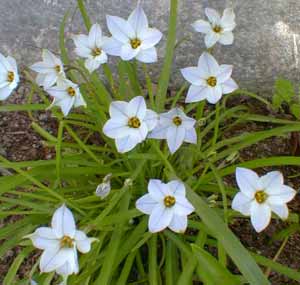
Spring Starflower;
or, Springstar
"Blooming flowers
residents of this world, too
for a short time."
-Kobayashi Issa
(1763-1827)
(1763-1827)
Ipheion uniflorum was formerly called Brodiaea uniflora, Triteleia uniflora, Milla uniflora, & has been assigned a few other genera over time.
It was recently moved yet again, & is currently properly called Tristagma uniflorum. But not everyone quite agrees with this latest change & frankly it remains more popularly known as Ipheion which serves more often as a common name than does Spring Starflower, so it continues to be listed as Ipheion or Ipheon uniflorum in garden catalogs.
Given its history of taxonomical disagreement, it could well be categorized again as Ipheion or something altogether different in another year or two.
 Ipheion produces thick patches of grass in autumn & winter, then produces six-petalled one-inch wide funnelled star-flowers predominantly in February & March, with occasional later flower appearing amidst the ipheion-grass until close to time for its summer die-back.
Ipheion produces thick patches of grass in autumn & winter, then produces six-petalled one-inch wide funnelled star-flowers predominantly in February & March, with occasional later flower appearing amidst the ipheion-grass until close to time for its summer die-back.The first photo was taken mid-February & the second photo is at the end of the first week in March (2004). At the end of March it looked like it was finished blooming, but then it had another flourish of heavy flowering in early April.
The flowers are such a pale violet as to nearly look white. There's a pure white form I. uniflorum alba, & a few named cultivars in various colors, including rich dark "Rolf Fiedler," light blue "Wisley Blue"), dark violet "Froyle Mill, or rosy pink "Charlotte Bishop," plus others, including an improved larger-flowered white called "Alberto Castillo." But ours is the basic wildflower native to Uruguay, Peru &am Argentina.
Now that I have seen how excellent it does in occasionally-dry bright shade, I will be adding some of its other varieties to the garden in the future. It's only drawback is its garlicky smell.
The smell repels animals from browsing on it too much. The slightest breeze seems to be enough to release the odor. This should be considered in giving it a position somewhere in the garden, for the odor of cooked onions isn't always the first thing one wishes to smell stepping out the door.
Ipheion naturalizes so swiftly it may seem weedy. It spreads by self-seeding & from bulb offsets. After a few years, if blooms begin to decline, clumps need to be dug up, bulbs divided, & replanted to start afresh. This can be done at spring's end or whenever blooms have declined, or as soon as the grass begins to die back. Bulbs only need to be set into the ground two or three inches.
It has the look of a richly green grassy bog plant but actually prefers well-draining soil, moist during the spring & fairly dry for its summer dormancy. Ours grows amidst an autumn-grassing Muscari botryoides grape hyacinths. Until they flower, their grasses mingle indistinguishably. They have nearly identical seasonal requirements.